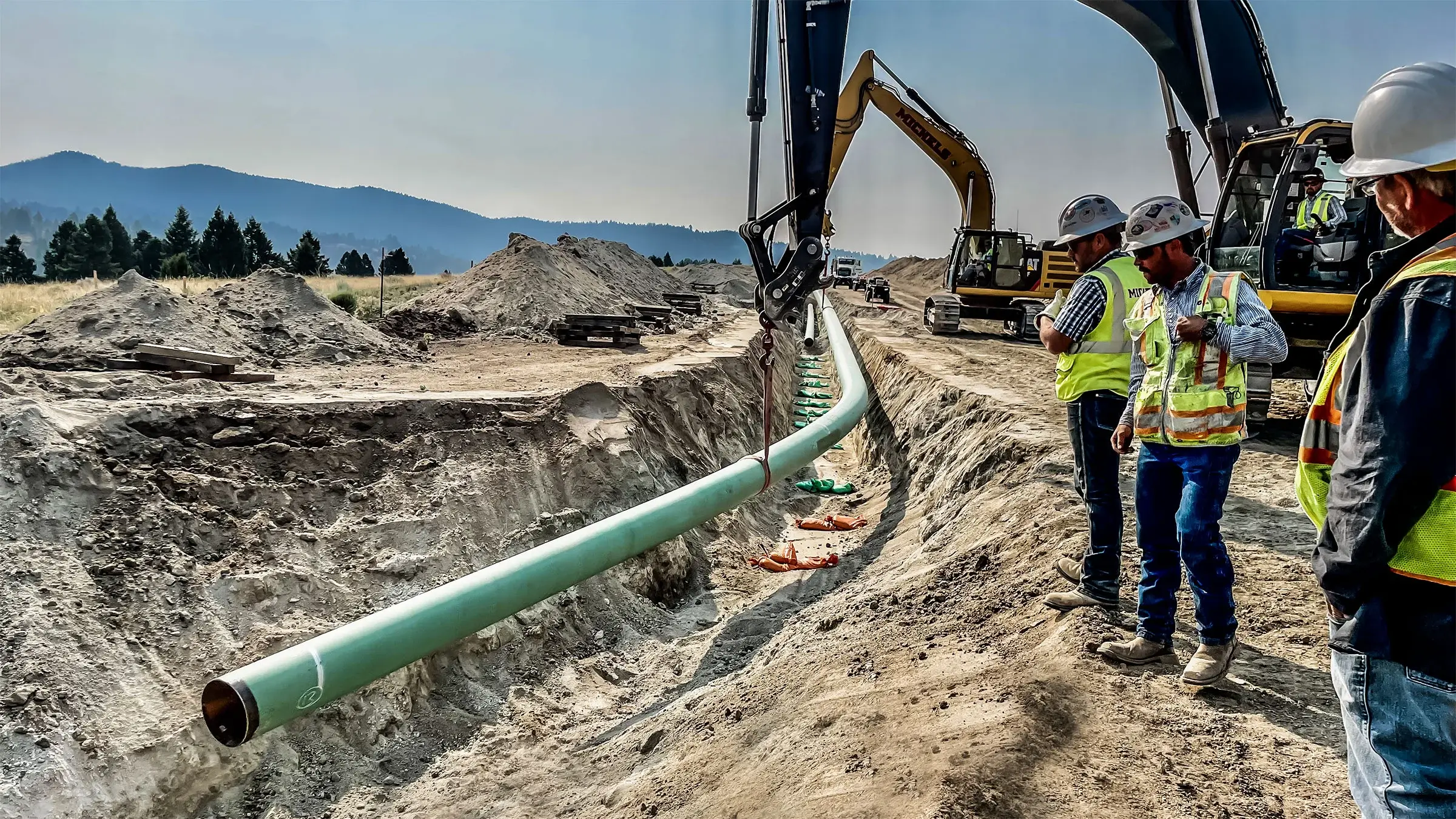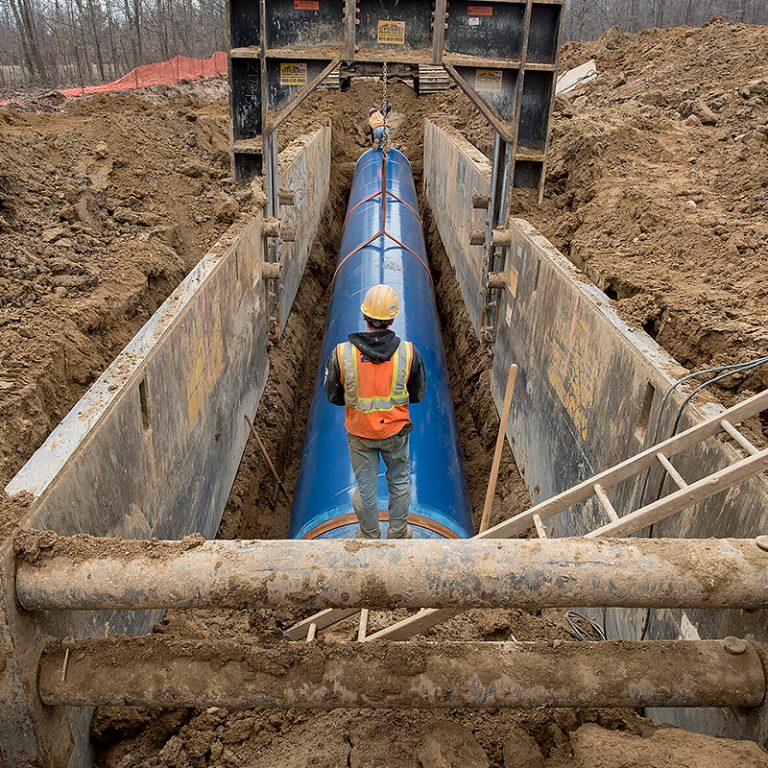Signs You May Need Immediate Help From Creek Pipe trenching services
A Deep Study Pipes Installation: Crucial Variables and Considerations for Successful Projects
Reliable pipe installation is a critical facet of engineering tasks. It entails a variety of elements, from product option to accurate sizing and design. Each choice can notably influence the system's effectiveness and longevity. Recognizing these elements is important for avoiding expensive mistakes. Creek Pipe HDPE installation. As teams navigate with the complexities of installation, several vital considerations arise that warrant attention. What are the essential elements that can make or damage a piping project?
Recognizing Pipe Materials and Their Applications
When choosing pipe products, one should think about the particular applications and ecological conditions they will encounter. Different materials supply distinct residential or commercial properties that deal with different demands. PVC is lightweight and resistant to corrosion, making it ideal for water circulation systems. Alternatively, steel pipes offer toughness and resilience, appropriate for high-pressure applications yet may call for safety coverings to avoid rust.Copper pipelines are preferred for plumbing due to their antimicrobial residential properties and simplicity of installation, while polyethylene is usually used in underground applications because of its versatility and resistance to cracking.The option of product additionally rests on temperature level extremes, chemical exposure, and installation place. For high-temperature applications, products like CPVC or PEX can be helpful. Inevitably, recognizing the features and constraints of each product help in making educated choices that improve system effectiveness and durability.
Value of Correct Sizing and Style
Appropriate sizing and style of pipes are essential for ensuring perfect flow rates and minimizing stress loss. These variables additionally play a considerable function in establishing the compatibility of products utilized in the installation. A systematic approach to sizing and layout can substantially boost the effectiveness and longevity of a piping system.
Effect On Flow Prices
Circulation rates in piping systems are critically affected by the sizing and layout of the pipes. Properly sized pipes guarantee that the liquid can relocate effectively, reducing disturbance and taking full advantage of flow ability. Large pipes can bring about decreased flow rates, while undersized pipes might restrict circulation, resulting in increased friction and possible obstructions. The design has to likewise consider variables such as pipe material, inner surface level of smoothness, and layout, as these add to the total efficiency of liquid transport. In addition, the plan of installations and connections within the system can influence flow prices. Meticulous interest to pipe sizing and layout is important for maximizing flow performance in any kind of piping installation project.
Stress Loss Considerations

Just how can push loss considerably influence the performance of a piping system? Stress loss is a vital aspect that can substantially diminish the performance of fluid transportation systems. When pipelines are poorly sized or made, excessive pressure loss may occur, resulting in reduced circulation prices and boosted power usage. This inadequacy can cause higher operational costs and potential system failures. Proper sizing and layout are essential to reduce pressure loss, ensuring that liquid characteristics stay suitable throughout the system. Designers need to very carefully think about elements such as pipe diameter, length, and product to achieve an effective equilibrium. Inevitably, attending to pressure loss during the design stage can improve dependability and durability, making it important for successful piping projects.
Product Compatibility Aspects
Pressure loss is not the only factor that can influence the efficiency of a piping system; material compatibility likewise plays a significant duty in total effectiveness. Ensuring that the products utilized in a piping system are compatible with the liquids they will deliver is vital. Different materials can respond negatively to various chemicals, bring about rust, degradation, or contamination. This can inevitably endanger the integrity of the system and influence its long life. In addition, correct sizing and style are very important to suit thermal growth and tightening, which can better affect material efficiency. Examining elements such as temperature level, pressure, and chemical make-up is vital in choosing appropriate products, thereby improving system integrity and decreasing upkeep costs in the long-term.
Methods for Accurate Pipe Installation
Exact pipe installation is vital for guaranteeing system effectiveness and durability. A number of strategies can boost the accuracy of this procedure. Careful measurement is important; installers ought to use quality tools such as laser levels and tape actions to figure out the exact lengths and angles required. Next off, correct pipe reducing methods, like utilizing a pipe cutter rather of a hacksaw, warranty tidy edges that help with better links. In addition, the usage of positioning tools, such as pipe jigs, can notably enhance accuracy throughout setting up. It is likewise recommended to consider thermal expansion; permitting for appropriate spacing and growth joints can protect against future imbalances. Lastly, the installation team need to comply with producer guidelines to abide by certain recommendations connected to each pipe type. By applying these methods, the possibility of leakages and system failures lowers, ultimately adding to a much more reputable piping system.
Ensuring Pipe Positioning and Assistance
Correct alignment and assistance are crucial to the honesty and performance of any piping system. Imbalance can lead to raised tension on joints, possible leakages, and minimized effectiveness. To guarantee correct placement, it is important to utilize proper tools such as laser levels and placement gauges. These instruments aid achieve exact positioning, ensuring that pipes are mounted according to layout specifications.Support systems must be created to suit thermal expansion and contraction, along with the weight of the pipelines and their contents. Picking the right kind of assistances, wall mounts, and brackets is imperative. Each ought to be installed at defined intervals to avoid drooping or undue tension on the pipes. Routine inspections following installation can help determine any type of imbalances or signs of inadequate support. By prioritizing alignment and support, one can considerably improve the longevity and capability of the piping system.
Common Installation Blunders to Avoid

Examining and Assessment for Quality Control
The installation process might appear full, complete testing and examination are important to guaranteeing the lasting dependability of a piping system. Various techniques are employed to examine the honesty of the installation, including stress tests, visual examinations, and non-destructive testing (NDT) strategies. Pressure examinations validate that the system can stand up to functional conditions without leakages, while aesthetic evaluations aid identify any kind of visible problems in the pipes or joints. NDT approaches, such as ultrasonic or radiographic testing, supply understandings into the product honesty without jeopardizing the system.Additionally, documenting the testing results is important for future referral and compliance with industry requirements. This documents serves not only as a top quality assurance step yet additionally as a legal protect. Inevitably, an extensive screening and examination protocol contributes to the general safety and security and efficiency of the piping system, ensuring it fulfills the required performance requirements gradually.
Upkeep Tips for Durable Pipe Systems
Maintaining a pipe system requires routine assessments and keeping an eye on to recognize possible concerns prior to they rise. Implementing effective cleaning techniques is also vital for protecting against buildup that can hinder performance. With each other, these techniques add to the durability and dependability of the piping facilities.
Routine Evaluations and Monitoring
Regular evaluations and tracking are vital for making sure the durability and effectiveness of pipe systems. Regular assessments can aid recognize prospective concerns such as leakages, rust, or obstructions before they rise right into significant problems. Applying a routine for routine inspections permits for the very early discovery of deterioration, allowing timely repairs. Surveillance pressure degrees and circulation rates can additionally offer beneficial insights into system performance, ensuring that any type of anomalies are resolved promptly. In addition, making use of innovative modern technologies, such as infrared electronic cameras or ultrasonic testing, can boost the assessment process by supplying comprehensive details regarding pipe conditions. Eventually, constant tracking and examinations contribute to cleanout pipe the reliability and longevity of pipe systems, lowering the threat of expensive repair services and downtime.

Reliable Cleaning Up Techniques
Efficient cleaning strategies are vital for maintaining the stability and functionality of pipe systems. Consistently arranged maintenance, such as flushing systems with water, aids remove particles and buildup. For even more persistent obstructions, specialists typically advise hydro jetting, which utilizes high-pressure water to tidy pipe interiors completely. Chemical cleansers can also be used however should be picked thoroughly to prevent destructive pipes. Furthermore, using tools like pipe cams can aid in determining trouble locations and guaranteeing efficient cleansing. Maintaining proper drain and staying clear of the disposal of hazardous compounds down pipes additionally add to longevity. Generally, regular cleansing practices not only improve performance however also reduce the danger of expensive fixings in the future.
Regularly Asked Questions
What Are the Labor Costs Connected With Pipe Installation Projects?
Labor expenses for pipe installation jobs vary commonly, influenced by elements like job intricacy, regional wage prices, and needed abilities (Creek Pipe Company). Generally, these costs can range from $50 to $100 per hour, depending on the workforce entailed
Just How Do Regional Laws Affect Pipe Installation Practices?
Regional policies significantly influence pipe installation practices by developing safety and security criteria, material specs, and installation methods. Conformity with these guidelines assurances project safety, environmental management, and adherence to regional codes, ultimately impacting total job success and costs.
What Tools Are Essential for Pipe Installation?
Necessary tools for pipe installation include pipe wrenches, cutters, and installations. In addition, sealers, measuring tapes, and degrees ensure accuracy and sturdiness. Proper tools advertises efficiency and adherence to safety and security requirements during the installation procedure.
How Can Climate Conditions Influence the Installation Refine?
Weather significantly influence the installation process, as severe temperatures, rainfall, or wind can affect product stability, employee security, and task timelines. Proper preparation and scheduling are essential to reduce these possible challenges throughout installation.
Are There Guarantees for Mounted Pipe Solutions?
Service warranties for installed pipe systems often vary by supplier and installation professional. Commonly, they cover problems and handiwork for a specific period, more helpful hints making sure the system's integrity and offering satisfaction to the home proprietor.